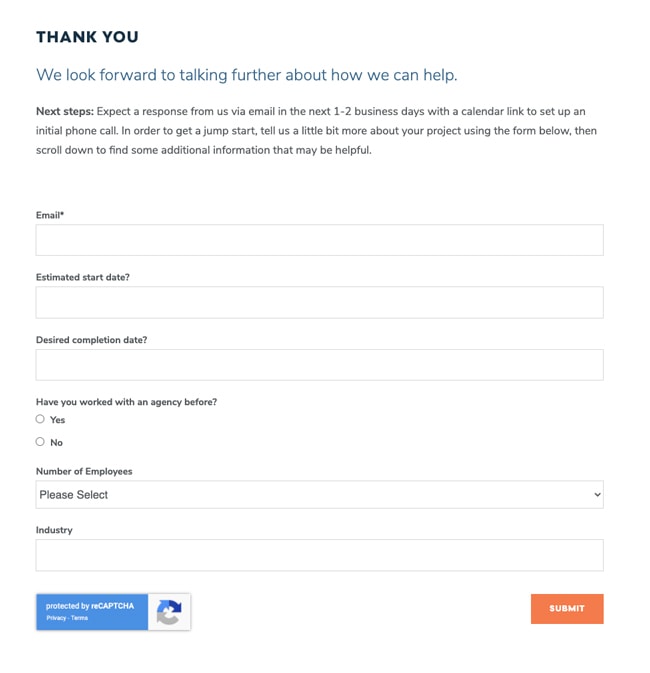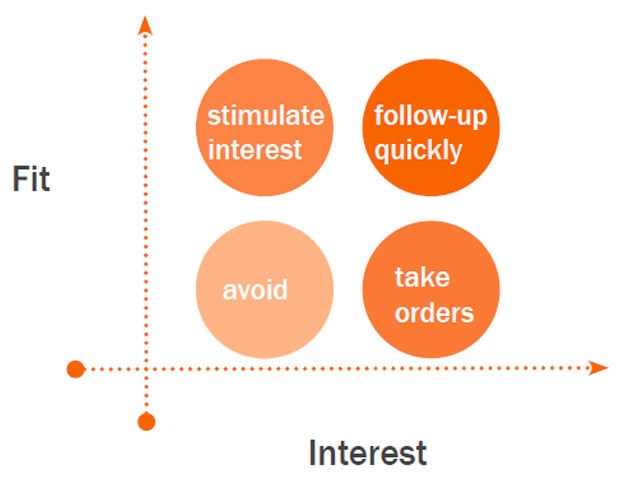B2B Post-Conversion Optimization: How to Turn More Leads Into Sales

As a B2B buyer, do you ever wonder what happens after you download a white paper or complete a sales contact form?
With more experience, sophisticated processes and better tools, B2B marketing leaders are discovering what happens after the conversion is one of the most critical moments in the sales and marketing process. Here’s a staggering fact: “79% of marketing leads never convert into sales.” (Search Engine People)
Why? The main reason is not nurturing your leads.
In this article, I share several ideas and insights on how to increase the percentage of marketing leads that convert into sales after a sales inquiry form is filled out.
- Attracting the Right Audience
- Post-Conversion Lead Generation Basics
- Build Confidence and Nurture Prospects
- Provide Clear Expectations For What Happens Next
- Make Sure Your Form and Thank You Mechanism Works — Always
- Managing Form Submissions Internally; Sales and Marketing Accountability and Followup
- Use Your CRM to its Full Potential
- The Deal Quality Report
- Turning More Leads Into Sales
Attracting the Right Audience
Your entire B2B website and marketing strategy is focused on one primary initiative — attracting the right audience, engaging them, and encouraging them to contact you when they’re ready to talk to your sales team.
If you follow our articles on how to create a high-converting B2B website, attract the right audiences with SEO, and engage them with CRO and marketing automation, you know the basics. And maybe even the next-level pieces are in place.
Where we see many companies lose their disciplined focus is in what happens next. Particularly in companies that are newer to digital marketing and aren’t accustomed to receiving valuable leads from their website.
For instance, after the prospect fills out the contact form on your website, are they left wondering if their message made it to anyone, or is stuck somewhere in cyberspace? Or, are they offered a way to engage further, connect, and gain confidence in your offerings and team?
Post-Conversion Lead Generation Basics
What happens “after the form” is critical for connecting marketing with sales, and generating increased revenue and ROI. Ask yourself:
- Do you have a reliable workflow in place to weed out poor-fit leads, connect with and close best fit leads, and nurture those who aren’t quite ready yet?
- Are you tracking which is which in a CRM?
- Are you closely tying those form submissions back to original sources so you can continue evolving your marketing to get smarter all the time, doubling down on what works, cutting out what doesn’t, and experimenting with new strategies?
Build Confidence and Nurture Prospects
To cover basic user experience (UX) needs, you’ll need a thank you message on the website after any form is submitted. This is a must-have; it confirms to your prospect the form message was sent.
Secondly, a nice-to-have for complex B2B sales is to offer next-level questions to increase participation in the sale on the client’s side, allow your team to vet their qualifications further, and prep for the sales call. Alternatively, you may want to promote an upcoming webinar or provide links to other high-value content to increase engagement.
As an example, below is Windmill Strategy’s contact form thank you page we use today (Figure 1). The minimum requirement is a short message, like the copy you see at the top. As an option, you can include the additional form fields, which helps you learn more about the prospect’s company and their intent.

Unbounce offers you five additional tips for optimizing your thank you pages:
- Invite them for a specific, strategic phone call
- Reveal the next steps
- Reinforce your brand personality
- Win them over first, then make a second ask
- Keep them engaged with your website
Provide Clear Expectations For What Happens Next
You’d be surprised how many engineers and B2B technical buyers have been burned by lack of sales followup, and don’t believe that thank you message to confirm that their message reached a human. To provide reassurance, send the recipient an automated email thanking them for their submission. You don’t need to send a copy of their message (this functionality can sometimes be hijacked by spammers), but do send a warm response. It’ll be general and the same for everyone, but try not to be too robotic with your language. Give them clear expectations of what to expect for next steps, and a timeline.
Here’s the format we use, for example:
Subject: Thank you for your interest in Windmill!
Hi [first name],
We received your inquiry, and look forward to talking further about how we can help. Expect a response from us via email in the next 1-2 business days with a calendar link to set up an initial phone call.
Thank you,
The Team at Windmill
A nice-to-have here is to provide an individual rep’s direct contact information and photo — but only if you’re receiving high-quality leads. If you need to evaluate and vet every lead before you send them to your sales team, we recommend not including the rep’s information here.
You could also consider offering links to a few high-quality articles or information for them to read in the meantime. In the case of a lead gen form or signup for a white paper or newsletter, definitely include links to your most appropriate content to keep them engaged, and a way to reach your sales team when they’re ready to talk further. For these lead gen forms or other “soft conversions,” you may want to use a workflow or other marketing automation system to enroll them in separate lead nurturing workflows based on certain actions they’ve taken on your website, or the specific conversion steps they’ve taken.
Make Sure Your Form and Thank You Mechanism Works — Always
And, of course, any time a change is made to your site’s software or contact form, it’s critical you perform tests on any contact forms on your site. The website’s primary purpose is that form, and the last thing you’d want is for it to not reach your sales team because of a technical glitch.
Managing Form Submissions Internally; Sales and Marketing Accountability and Followup
We see different sales organizations handling these steps in a variety of ways. If overall lead quality is poor and you’re getting too many unqualified leads, read this article, but this leads many sales organizations to keep these leads out of their CRM, and have marketing sort through them individually, only to add qualified leads to the CRM.
To have full transparency and visibility and track good- and bad-quality leads back to sources, connect your forms to a CRM such as HubSpot. When you do, you can judge their quality within the CRM and determine who to unsubscribe (spam submissions), who to vet further, and who to send directly to a sales rep.
By integrating your forms with your CRM, you’ll have a full data-driven picture, avoid duplicate manual entries, sidestep potential miscommunications, and keep quality leads from slipping through the cracks. And by maintaining a disciplined process of evaluating all leads and assigning a numeric score based on their fit for your organization—over time you can compile information that shows you critical information about where the best leads come from:
- Organic search (and which pages?)
- PPC (and which campaigns, which keywords?)
- Referral sources
- Directory listings, and others
To avoid overwhelming sales reps with too much “noise,” a large sales organization could have two pipelines. One for all new sales inquiries to land in MQL (marketing qualified leads). The other for vetted good-fit prospects that are sales-ready (SQL). Once these leads appear in this pipeline within the CRM and become subscribers to your content, a sales associate or marketing team member should evaluate and categorize the new leads as:
- Spam — unsubscribe and ignore (delete from HubSpot)
- Poor fit — email a few predefined vetting questions and ignore if you don’t get a response.
- Questionable/unsure — call or email these leads and go over a few predefined vetting questions ahead of connecting them with sales. Set up a meeting with sales if they seem like a good fit, keep in touch via marketing if not qualified or not ready yet.
- Good fit /ready — send an email ASAP with the sales rep’s contact info and calendar link, asking the prospect to set up a meeting. Sales gets notified when the call’s booked, and has access to the prospect’s data within the CRM. You can also use a marketing automation tool to book these calls within the invite. (Now, you can create a deal or opportunity in the CRM and move them to the SQL pipeline.)
Read more on vetting leads, and the path from MQL to SQL in this article by HubSpot. During your vetting process make sure you evaluate fit (Figure 2).
- Are they a match for your ICP and represent the type of work you want to sell more of?
- Are they ready to buy?
- Or are they just getting started in the research phase and need more nurturing by marketing?
- You want to prioritize where to spend your sales team’s precious time, focusing on the best qualified, highest fit and interest prospects.

Use Your CRM to its Full Potential
We find many B2B sales teams aren’t using CRMs to their fullest potential, or sometimes not at all. Plan A is to encourage your sales team to use the CRM as the source of truth. Log all call notes, internal estimating conversations, contact information, deal quality and revenue potential within the CRM.
If you’re one of the many marketing teams that haven’t adopted a CRM or marketing automation, plan B is to regularly meet with sales to manually track revenue numbers, wins/losses, and deal quality.
Even if you’re not using a CRM to hold sales notes and information, consider doing so and move away from disparate apps like email and spreadsheets. CRM’s are are custom-built to hold information like the following on every deal and opportunity:
- Contact info
- Pipeline stage
- Potential revenue
- Likely close date
- Source
- Quality
Keep in mind that time is critical when you’re qualifying, vetting and responding to leads. Your prospect may be reaching out to multiple companies in one session, and very often the first person to respond ends up with the sale. According to a Demand Gen B2B Buyers Survey, two-thirds of B2B buyers say the timeliness of a vendor’s response to inquiries is a key factor in where they buy. Said Forbes, “Even if your prospective customers are dragging their feet, you need to be on the spot with messaging and content tailored to each buyer’s needs, industry, and challenges.”
The Deal Quality Report
In addition to the standard analytics, dashboards and metrics tracked by most digital marketing teams, which track engagement, traffic, conversions, and other critical performance metrics, the holy grail is the deal quality report.
By exporting from HubSpot regularly a report of deals from your sales team, you can fine-tune your marketing to get increasingly smarter over time. These reports include the deal source (Organic, PPC, Social, Cold Email, Paid Social, Referrals), as well as the specific campaigns.
This intelligence includes data such as ad clicks, keywords, first page seen and referring website, for instance. Combining information from both marketing and sales results in a numeric deal quality score. Without feedback from sales, digital marketing teams can easily create more traffic or conversions that don’t fit your company’s ideal customer profile, which wastes your sales team’s time.
Steps to updating your deal quality report:
- Start with a Google sheet or an Excel spreadsheet to use as a master list of all the deals week-to-week.
In the sheet, start by creating a tab for the week you’re wanting to track. Week-over-week create a new tab for the new week and name them in a way where you can keep track which week is which. (Example: Week of Aug 15th, 2020) - Pull deal information from your CRM. This information should include contact name, deal value, source type, conversion points and more. If you’re pulling data from HubSpot, you can collect this information using the following steps.
- Navigate to the “Deals” section of your HubSpot account.
- Click the “Create Date” filter and select the desired date range. Since this will be a snapshot of the previous week, you can select “Last Week”.
- To download this list, click “Table actions” and select “Export view” to download as an XLSX or CSV sheet.
- Filter these deals by current client and newly acquired leads. This exercise helps you evaluate new leads.
- Filter to compare paid leads against organic leads; and, evaluate separately.
After adding data from your CRM, note the estimated quality of that deal on a 1-10 scale. Take your best guess but revise after input from sales; a numeric value helps you sort and compare multiple deals.
Make a habit of updating your deal spreadsheet with new leads each week to spot trends and develop a clear picture of the sources of your good and bad leads. We recommend looking through the deal quality report weekly, as well as a quarterly summary highlighting wins. After all, this is what you’re going for, high-quality deals that convert into sales.
Download a free example deal quality template
Turning More Leads Into Sales
The more you follow through on the post-conversion optimization ideas we’ve shared here, the more successful you’ll be converting more leads into sales. From attracting the right audience to nurturing prospects to managing form submissions and measuring deal quality, you’ll have a solid foundation to help you grow your business.


